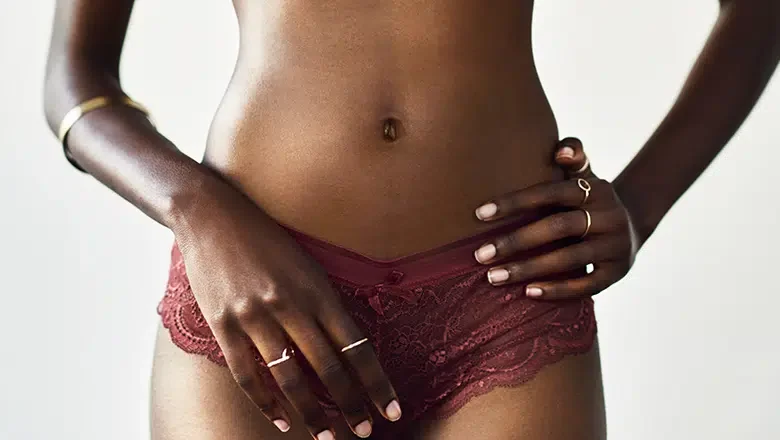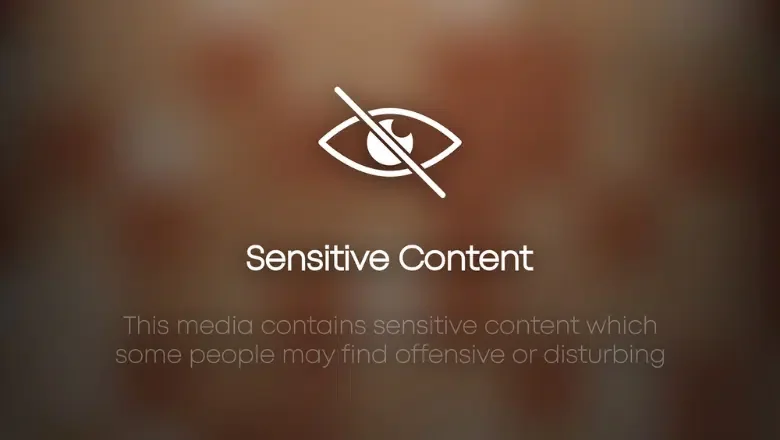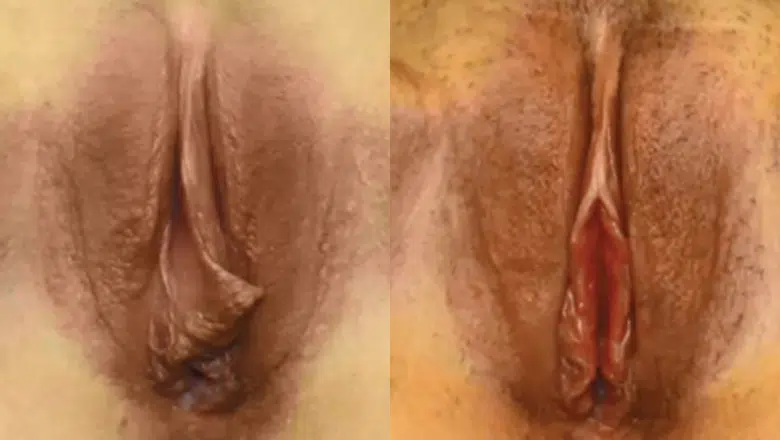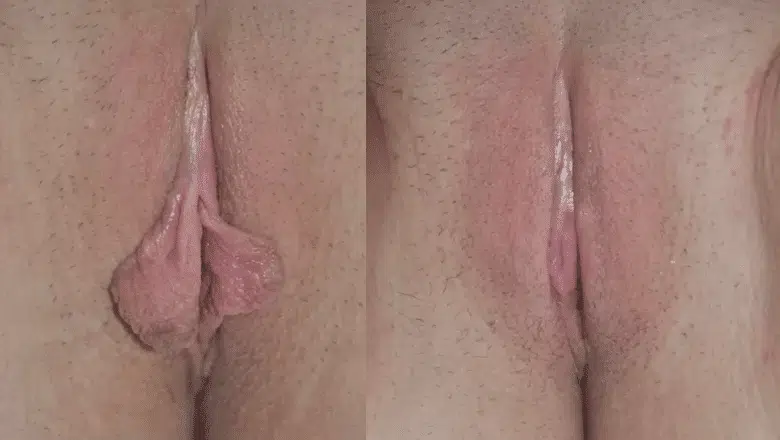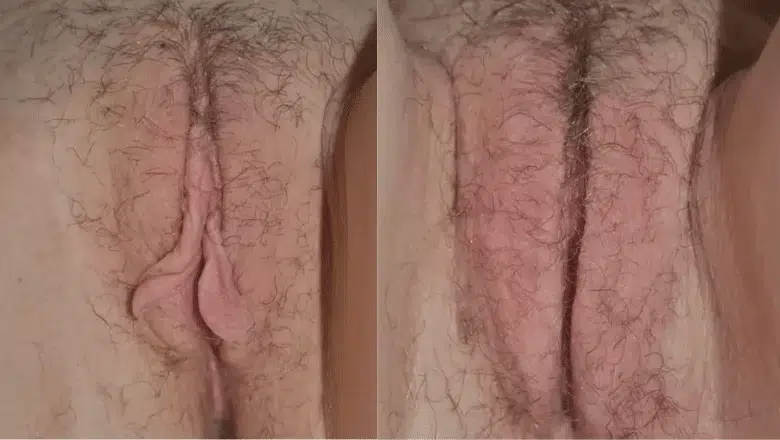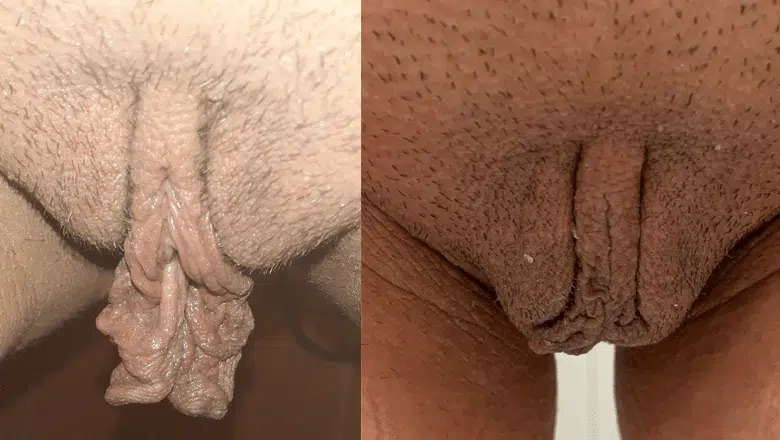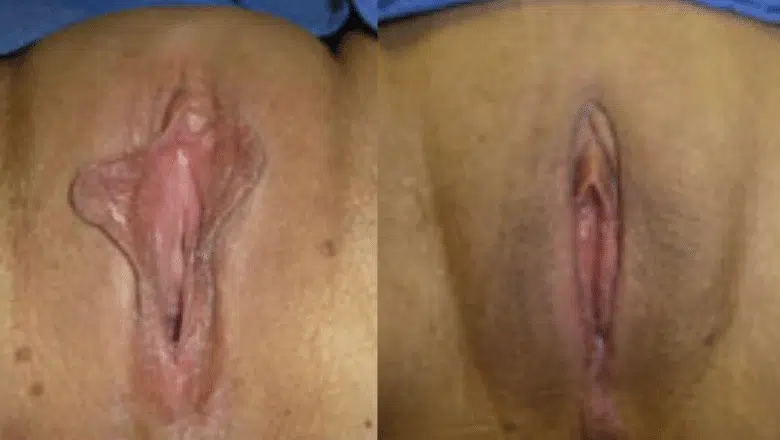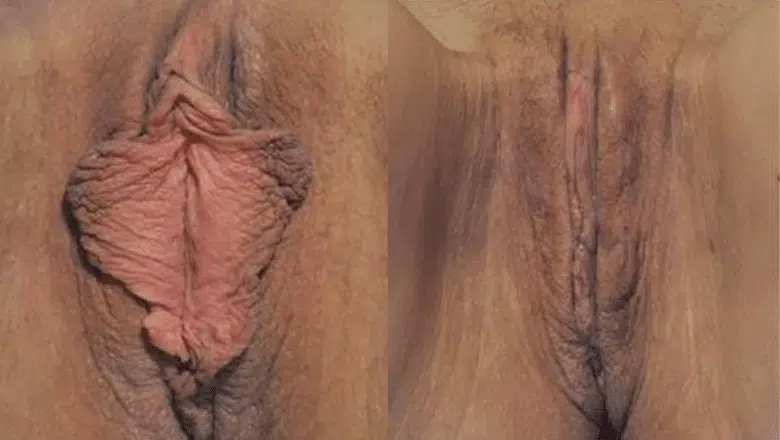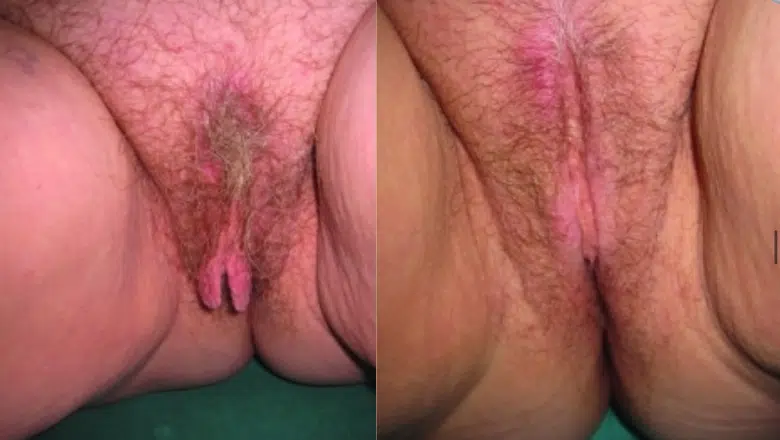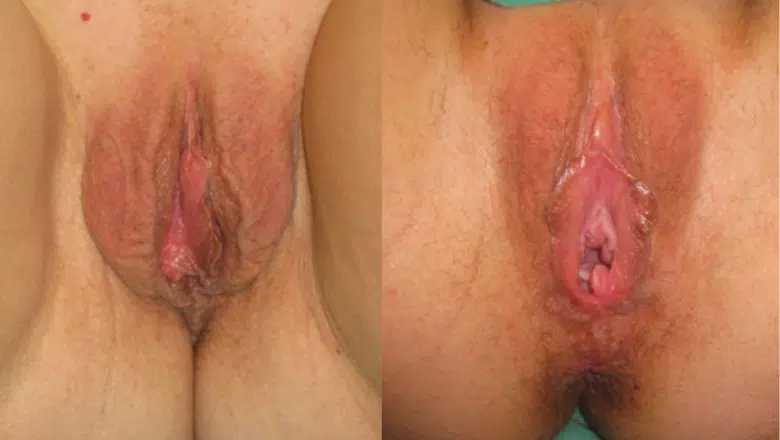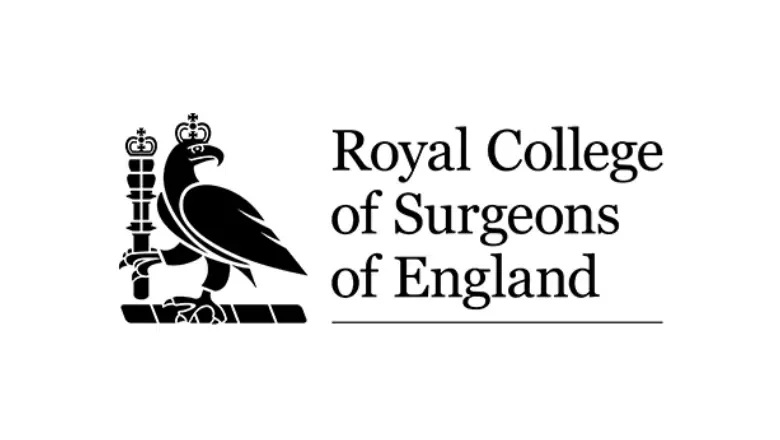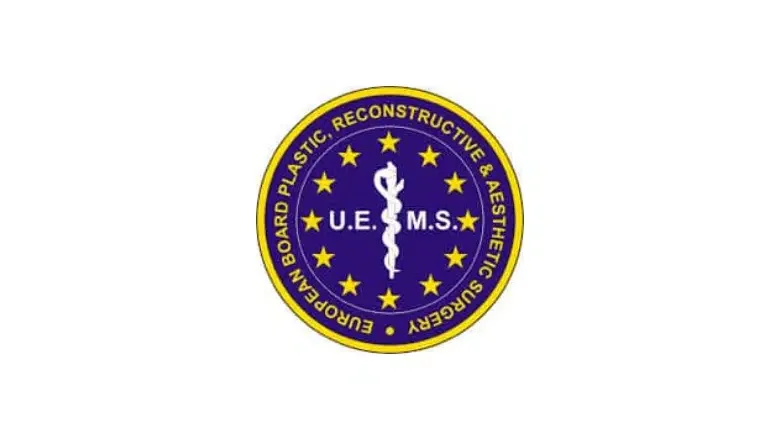Clitoral Hood Reduction: London & UK
Reclaim your confidence and comfort with our hoodectomy procedure, a quick and minimally invasive solution for excess labial tissue
Clitoral hood reduction, also known as hoodectomy, is a surgical procedure designed to reduce the size of a prominent clitoral hood. The clitoral hood is also known medically as the prepuce and functions as a protective layer over the clitoris in between periods of sexual arousal.
The clitoris itself is highly sensitive, and the clitoral hood retracts during sexual intercourse to facilitate clitoral stimulation. In some cases, excessive tissue forms part of the clitoral hood, which may prevent its ability to fully retract during sexual intercourse, which results in reduced stimulation of the clitoris. Clitoral hood reduction or hoodectomy is a straightforward procedure that involves the surgical removal of excess clitoral hood tissue located on either side of the clitoris, which results in a smaller clitoral hood that is better able to retract. Clitoral hood tissue may be carried out on its own or may be combined as part of a labiaplasty (labia reduction) procedure to reduce the size of large labia at the same time.
RELATED: What is Hoodectomy or Clitoral Hood Reduction?
Hoodectomy surgery is a safe and highly effective operation which takes approximately one hour to carry out. The clitoris itself and its associated nerve endings are left untouched by clitoral hood surgery. The procedure is designed to remove excessive clitoral hood tissue, which results in a greater surface area of the clitoris, which can be exposed and stimulated during sexual intercourse. Many women report increased levels of sexual pleasure after a hoodectomy.
RELATED: How to choose the best labiaplasty surgeon
The procedure is designed to expose a greater part of the clitoris, increasing the amount of stimulation achieved during sexual intercourse. However, clitoral hood surgery may not necessarily increase the chances of women achieving orgasm. The ability to achieve an orgasm is linked to several interconnected factors, including emotional state, sexual desire and one’s state of health aside from having a normally functioning clitoris. Although the surgery is carried out in the region of the clitoris, it is important to remember that a hoodectomy does not involve surgical alteration of the size or shape of the clitoris itself. The surgeon takes great care to ensure the clitoris is left untouched during the procedure.
RELATED: What is a Labiaplasty?
What is Clitoral Hood Reduction?
A clitoral hood reduction, also known as a clitoral hoodectomy or clitoral unhooding, is a surgical procedure that reduces the size and prominence of the clitoral hood. The clitoral hood is the fold of skin at the top of the labia minora that covers the clitoris, providing protection and sensitivity.
RELATED: Debunking Common Myths About Clitoral Hood Reduction
In some women, the clitoral hood can be overly large or thick, potentially causing aesthetic concerns or interfering with sexual stimulation. A clitoral hood reduction aims to address these issues by removing excess tissue to expose more of the clitoris, which can enhance the visual appearance of the vulva and potentially increase sexual sensitivity.
Hoodectomy Before & After Photos - Real Patient Results
RELATED: Labiaplasty before and after photos
Benefits of Clitoral Hood Reduction
A clitoral hood reduction can offer several potential benefits. Individual experiences may vary, and the decision to undergo this procedure should be made in consultation with a specialist surgeon who can provide personalised advice based on your unique circumstances. Here are a few potential benefits:
Improved Aesthetic Appearance
Some women may feel self-conscious about the appearance of an enlarged clitoral hood. A clitoral hood reduction can help to create a more balanced, symmetrical appearance of the vulva, which may enhance self-confidence and comfort with one’s body.
Increased Sexual Sensitivity
An overly large clitoral hood can sometimes diminish sexual sensation because it can cover the clitoris more than usual. By reducing the size of the clitoral hood, more of the clitoris can be exposed, potentially increasing sensitivity during sexual activity.
Reduced Discomfort
In some cases, an enlarged clitoral hood can cause physical discomfort, such as during sexual intercourse or when wearing certain types of clothing. A clitoral hood reduction may alleviate this discomfort.
Enhanced Hygiene
Excess skin in the genital area can sometimes contribute to hygiene issues. Reducing the size of the clitoral hood may help some women maintain cleanliness in the area.
Am I Suitable for Clitoral Hood Surgery?
Your surgeon will carry out a detailed clinical assessment to determine your suitability for clitoral hoodectomy. Patients should be:
- In good physical and mental health with no serious medical conditions
- Concerned about the appearance function of the clitoral hood
- Are aware of what surgery can achieve and have realistic expectations
Many women may also experience the following symptoms:
- A reduction in sexual enjoyment due to excessive clitoral hood tissue
- Experience pain and irritation caused by an oversized clitoral hood rubbing on clothing
- Exercise-induced discomfort caused by clitoral hood irritation
- Excessively large clitoral hood as a result of childbirth or the natural ageing process
Women who have an excessively large clitoral hood may develop a loss of self-confidence which may manifest in symptoms of anxiety and possible depression. Women concerned about the clitoral hood’s appearance can benefit from a hoodectomy to improve appearance and function.
Preparing for Clitoral Hood Reduction
Preparing for a surgical procedure like clitoral hood reduction is crucial to ensuring a successful outcome and a smooth recovery. Taking the time to follow preoperative guidelines can make a significant difference in how well your body responds to the surgery and how quickly you heal.
One of the most important steps you can take is to stop smoking well in advance of your surgery. Smoking can seriously hinder the healing process by reducing blood flow, which is vital for tissue repair. Ideally, you should quit smoking at least six weeks before and after your surgery to give your body the best chance of healing properly.
Similarly, it’s advisable to avoid alcohol in the weeks leading up to your surgery. Alcohol can impair your body’s ability to heal and may also interfere with anaesthesia or other medications you might be prescribed. By steering clear of alcohol, you help ensure that your body is in the best possible condition for the procedure.
Hygiene is another key aspect of pre-surgery preparation. On the day before your surgery, it’s important to clean the surgical area thoroughly. Your surgeon will likely provide specific instructions on how to do this, which may include showering, scrubbing the area, and possibly shaving. Proper hygiene reduces the risk of infection and sets the stage for a smoother recovery.
It’s also essential to review any medications you’re currently taking with your surgeon. Certain medications, especially blood thinners and herbal supplements, can increase the risk of bleeding during and after surgery. Your surgeon may advise you to adjust or temporarily stop these medications to minimise any potential complications.
In some cases, your surgeon may request a preoperative medical evaluation or lab tests to confirm that you are in good health for the procedure. These evaluations help identify any underlying conditions that could affect the surgery or your recovery, allowing for any necessary adjustments to your care plan.
Comfort is key during the recovery period, so it’s a good idea to invest in loose-fitting, breathable clothing, particularly bottoms that won’t irritate the surgical site. Having comfortable clothing ready will make it easier to rest and recover after the procedure.
It’s also wise to plan for some time off work. Giving yourself adequate time to heal without the stress or strain of your job will support a more effective recovery. The exact amount of time you’ll need can vary, so discuss this with your surgeon to ensure you schedule enough leave.
Preparing your home in advance can also make your recovery period more comfortable. Consider doing your grocery shopping, preparing meals, and setting up a cosy area where you can rest. Having everything ready before your surgery means you won’t have to worry about these tasks when you should be focusing on healing.
Lastly, it’s important to avoid any strenuous physical activity, including exercise, for at least 24 hours before your surgery. This allows your body to be in its best condition for the procedure, reducing the risk of complications and promoting a better recovery.
What does a clitoral hoodectomy involve?
The clitoral hood reduction procedure aims to improve the aesthetic appearance while maintaining functionality.
The procedure is comfortably performed with a local anaesthetic, and the option of mild oral tablet sedation is available, which may make you feel drowsy. The injection of a local anaesthetic renders the area fully numb, meaning there is little or no discomfort during the procedure. However, if you do not wish to be awake for the procedure, TIVA general anaesthetic is available. Clitoral hood reduction takes about one hour to perform.
RELATED: Is labiaplasty painful?
There are different methods for completing the clitoral hood reduction. These include:
Bilateral excision
The prepuce tissues that cover the clitoral glans are removed, and the glans in the middle are maintained.
Excision of redundant folds
As the name suggests, the redundant folds of the clitoral prepuce tissue are surgically removed. In this case, the incisions are made parallel to the long axis of the clitoris to reduce the risk of sensory disturbances to the clitoris.
The clitoral hood reduction is often performed as part of a labiaplasty, which involves reshaping the labia minora. With a combined labia minora reduction and clitoral hood reduction, the procedure takes about 2 hours to complete.
Recovery after Clitoral Hood Reduction
After having a clitoral hood reduction, it is normal to experience some swelling and bruising. You may also experience some pain and discomfort. Your surgeon will be able to give you medication to take if you need help managing pain levels. Ice packs can be used to help reduce swelling. Most people must take at least two to three days off to recover from surgery. You will have sutures in place. However, these will dissolve over the following few days. You should wear a sanitary pad for the first week to help with any bleeding. Any rigorous physical activity – including any sexual intercourse – will have to be avoided for at least one month.
Risks of Hoodectomy
As with any surgical procedure, clitoral hood reduction carries certain rare risks. Risks associated with this procedure include:
- Wound separation
- Asymmetry
- Infection
- Reactions to the anaesthetic
Our surgeons take all relevant precautions to ensure that the likelihood of complications occurring is minimal.
Clitoral Hood Reduction Cost & Price – How much is Clitoral Hood Reduction in London ?
The cost of a clitoral hood reduction procedure is influenced by several factors, including the expertise of the surgeon, the specific requirements of the surgery, and the facilities used for the operation. As such, the cost can vary significantly from one surgeon or clinic to another.
Given the elective and aesthetic nature of clitoral hood reduction, it’s important to note that it is not typically covered by the NHS or private medical insurance, as it’s not generally considered a medically necessary procedure. Therefore, you will likely need to arrange for private payment for the procedure.
For a personalised estimate of the cost of a clitoral hood reduction procedure in London, we invite you to contact the Centre for Surgery. Our team can provide a more detailed consultation and quotation based on your circumstances. You can reach us at 0207 993 4849 to discuss further details, book a consultation, and learn more about the procedure, its potential benefits, and how it may be able to help you achieve your desired aesthetic goals.
We look forward to assisting you with your journey.
Clitoral Hood Reduction in London: Discover Excellence at Centre for Surgery
Unparalleled Expertise and Patient-Centric Care
At Centre for Surgery, we pride ourselves on our dedicated team of highly qualified plastic surgeons who specialise in genital aesthetics, including clitoral hood reduction. Our surgeons are committed to delivering bespoke treatments tailored to each patient’s unique needs and aesthetic goals, ensuring outcomes that are both natural-looking and harmonious with the overall genital appearance.
Our state-of-the-art clinic on Baker Street in London is equipped with the latest in medical technology, providing a safe and welcoming environment for all our patients. We adhere to stringent safety protocols and are continuously updating our practices to reflect the latest advancements in the field of plastic surgery.
Why Patients Choose Centre for Surgery:
- Expert Surgeons: Our team consists of surgeons who are leaders in the field of cosmetic and plastic surgery, each bringing a wealth of experience and a dedicated approach to patient care.
- Comprehensive Consultation Process: We believe in the importance of thorough consultations, where your surgeon will discuss your concerns, expectations, and the details of the clitoral hood reduction procedure, ensuring you are fully informed and comfortable with your treatment plan.
- Bespoke Treatments: Understanding that each patient is unique, we offer customised treatment plans designed to achieve the best possible outcomes, aligning with your individual aesthetic goals.
Patient Testimonials
- Emma, London: “Choosing Centre for Surgery for my clitoral hood reduction was the best decision I ever made. The care and attention to detail from my surgeon and the entire team were exceptional. I felt supported throughout my journey, and the results have truly exceeded my expectations.”
- Sophie, Essex: “The professionalism and expertise at Centre for Surgery are unmatched. From the initial consultation through to my recovery, I felt in safe hands. The difference this procedure has made to my confidence is incredible.”
- Lauren, Kent: “I was nervous about undergoing surgery, but the warm and welcoming team at Centre for Surgery made all the difference. The results are absolutely perfect, and I couldn’t be happier with my decision.”
Booking Your Consultation
To start your journey towards renewed confidence with clitoral hood reduction, contact us today to book your consultation. Our friendly team is here to answer any questions you may have and guide you through every step of the process.
📞 Phone: 0207 993 4849
📧 Email: contact@centreforsurgery.com
📍 Address: 95-97 Baker Street, London W1U 6RN
Additional Resources
For more detailed information about our clinic and the procedures we offer, please visit our About Us page: https://centreforsurgery.com/why-us/.
Interested in exploring finance options, including 0% APR with Chrysalis Finance? Find out more here: https://centreforsurgery.com/finance-options/.
For insights, tips, and detailed articles on plastic surgery, head over to our blog: https://centreforsurgery.com/blog/.
Have any questions? Our comprehensive FAQs page might have the answers: https://centreforsurgery.com/cosmetic-surgery-frequently-asked-questions/.
Explore our Baker Street clinic further here: https://centreforsurgery.com/clinic/95-97-baker-street/.
Centre for Surgery is not just a clinic; it’s a place where patient care, safety, and satisfaction are our utmost priorities, ensuring you receive the highest standard of care from consultation through to recovery. Choose Centre for Surgery for your clitoral hood reduction in London and take the first step towards achieving your desired aesthetic with confidence.
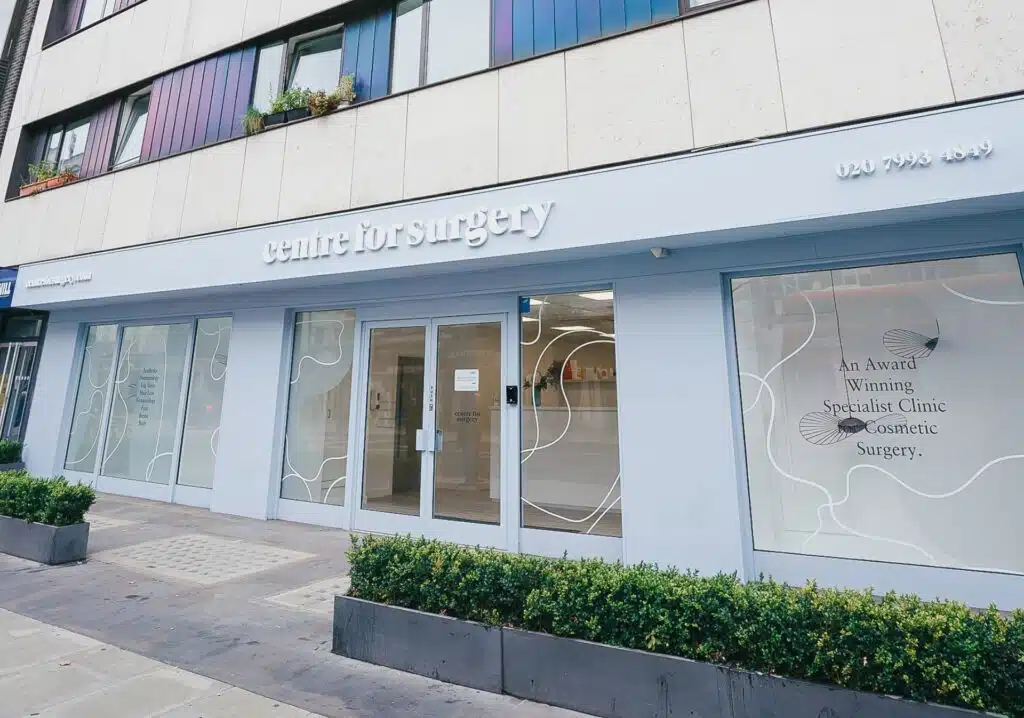
FAQs
-
Can you have surgery on your clitoris?Yes, there are surgical procedures that can be performed on the clitoris and the tissue surrounding it, but these are generally undertaken for specific medical reasons or for aesthetic purposes. Two such procedures are clitoral hood reduction and clitoropexy.
Clitoral Hood Reduction: Also known as clitoral unhooding, this procedure involves the removal of excess tissue from the clitoral hood. This can be done for aesthetic reasons or to increase clitoral sensitivity, though individual results may vary.
Clitoropexy: This is a surgical procedure where the clitoris is repositioned due to its abnormal position. It's generally performed in cases of congenital conditions or when the clitoris has been affected by trauma or surgery.
It's essential to remember that any surgery involving the clitoris must be undertaken with extreme care, as this area is highly sensitive and rich in nerve endings. Incorrect surgical intervention can lead to complications, including changes in sensation, pain, or sexual dysfunction. -
Does labiaplasty include hood reduction?Labiaplasty and clitoral hood reduction are two separate procedures that can be performed independently or together, depending on the individual's goals and needs.
Labiaplasty primarily focuses on the labia minora and/or labia majora, which are the external parts of the female genitalia. The procedure involves reshaping or reducing the size of the labia to address concerns such as discomfort, asymmetry, or aesthetic dissatisfaction.
Clitoral hood reduction, on the other hand, specifically targets the clitoral hood, which is the fold of skin that covers and protects the clitoris. This procedure involves reducing the size of the clitoral hood to enhance exposure of the clitoris, potentially increasing sensitivity or addressing aesthetic concerns.
While labiaplasty and clitoral hood reduction can be performed separately, they can also be combined into a single surgical procedure if a patient desires both. This combined procedure is sometimes referred to as a "labiaplasty with clitoral hood reduction" or "labiaplasty with clitoral unhooding." -
Can clitoral hood reduction be combined with labiaplasty?Clitoral hood reduction is commonly performed at the same time as a labiaplasty procedure. Labiaplasty or labour reduction is designed to reduce or reshape the labia menorah which are the inner lips of soft tissue located on either side of the vagina. The most common method of reducing the size involves surgical removal with a scalpel before stitching back the cut edges with dissolvable stitches. Your Surgeon can easily combine labia reduction with a hoodectomy at the same time.
If clitoral hood reduction is combined with a Labiaplasty, there may be a greater amount of swelling in the recovery period which may necessitate a longer period of time off work allow proper healing. The most appropriate treatment options will be discussed at your consultation with an expert surgeon. -
Does clitoral hood reduction increase sensitivity?One potential benefit of this procedure can be an increase in clitoral sensitivity. In cases where an overly large or thick clitoral hood has been limiting direct stimulation of the clitoris, a clitoral hood reduction may allow for increased exposure of the clitoris, potentially enhancing sexual sensitivity.
-
Will I lose feeling if I have a clitoral hood reduction?Clitoral hood reduction, also known as clitoral unhooding, is a procedure designed to reduce the size of the clitoral hood, which is the fold of skin that protects the clitoris. The procedure is usually performed for cosmetic reasons or to potentially increase sensitivity, but it's important to be aware of the possible risks and complications.
In terms of sensation, the clitoral hood doesn't contain as many nerve endings as the clitoris itself, so the risk of losing sensation due to a clitoral hood reduction is generally low. However, any surgical procedure carries some risk, and potential complications can include changes in sensation, both increased and decreased.
In most cases, a well-performed clitoral hood reduction should not result in a loss of feeling. Some women even report increased sensitivity due to more direct exposure of the clitoris. -
How long does hoodectomy recovery take?Clitoral hoodectomy requires approximately six weeks for full recovery to take place as long as you continue to follow all the post-operative after-care instructions given to you by your surgeon. There are several ways to improve healing including avoiding having bath too early for at least the first two weeks after surgery. When you go to the toilet, you should dab the area to dry it rather than rubbing the area which may cause irritation. We would recommend sleeping with your pelvis elevated when sleeping to reduce swelling.
Swelling can be reduced further by applying cold packs temporarily for no more than 20 minutes at a time. They can be reapplied once 20 minutes have passed. -
How painful is clitoral hood reduction?A clitoral hood reduction, like any surgical procedure, can cause some discomfort, but measures are taken to minimise this. The procedure itself is performed under local or general anaesthesia, meaning you will not feel pain during the surgery.
Postoperatively, some degree of discomfort or pain is to be expected as you heal. This can usually be managed effectively with over-the-counter pain relievers or prescribed medication as directed by your surgeon.
Other common postoperative symptoms can include swelling, bruising, and sensitivity in the surgical area, which should gradually subside over a few days to a week. Ice packs can be applied to the area to help reduce swelling and discomfort. -
What are the common side-effects and potential risks of hoodectomy?As with any surgical procedure, clitoral hood reduction involves certain risks. The most common risks include minor bleeding, wound infection, wound breakdown or minor asymmetry. When performed by an expert surgeon, thankfully these risks are rare. The risk of severe bleeding is minimal with this procedure due to its minimally invasive nature.
Certain serious risks of surgery include allergy to medicines used during the procedure, deep vein thrombosis or severe wound infection. These risks are rare due to the strict safety protocols used during your surgery.
If you have further questions about the risks and complications of hoodectomy, please discuss these with your surgeon at the consultation. -
Will I have scars after hoodectomy?Any type of surgery involving an incision will result in a scar. Clitoral reduction surgery involves minimal scarring due to the minor nature of the procedure. A greater amount of scarring may occur when the procedure is combined with a labiaplasty although overall the amount of scarring is still minimal and will be barely visible either to yourself or others.
Any type of scar after surgery is always more noticeable during the first four weeks but will settle down over time and the appearance of scars can be improved by following expert scar management advice from our postoperative nurses. -
When can I exercise after clitoral hood reduction?The timing for resuming exercise after a clitoral hood reduction can vary depending on the individual and the specific details of the surgery. It's important to consult with your surgeon for personalized advice based on your unique circumstances.
In general, it is recommended to avoid strenuous exercise and activities that may cause excessive friction or pressure on the surgical area for several weeks following the procedure. This allows for proper healing and reduces the risk of complications. -
When can I resume sexual activity after hoodectomy?It is important to avoid sexual intercourse for the full six weeks after clitoral hood surgery. Sexual intercourse should only be resumed once any symptoms of pain or discomfort have fully resolved. If you develop pain during sexual intercourse, you should wait for a longer period of time before having sexual activity again.
Women should avoid the use of tampons for six weeks after hoodectomy as these may interfere with wound healing. If you would like to use alternative sanitary products, please speak to one of our post-operative nurses for further advice on suitable products to use. -
Are the results of clitoral hoodectomy permanent?The results of a clitoral hoodectomy, or clitoral hood reduction, are typically considered permanent. The procedure involves the removal of excess tissue from the clitoral hood to expose more of the clitoris, potentially enhancing sensation and addressing aesthetic concerns.
After the surgical procedure, the clitoral hood will be permanently reduced in size. This means that the changes made during the procedure are intended to be long-lasting.


